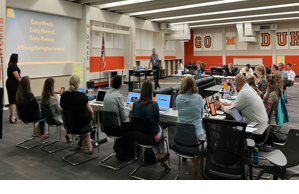Revisiting Ohio's Improvement Model: Three Districts Describe their Experience in Using the OIP to Improve Adult and Student Performance

Originally designed in 2007 as Ohio’s continuous improvement framework, the Ohio Improvement Process (OIP) has been continually refined and updated. These ongoing efforts expand the usability of the OIP as a strategy for supporting district-wide implementation of evidence-informed practices for improving teaching and learning for all children.
Then and now, the OIP provides the foundation for systemwide change and improvement in the majority of Ohio’s school districts and community schools.
The OIP continues to be a statewide tool – accessible to all districts. It also provides a common framework for all regional providers (e.g., state support team personnel) to use in supporting districts in their regions; and it positions Ohio’s statewide system of support (SSoS) to provide consistently high-quality technical assistance to any district, regardless of where that district is located in the state.
So What’s the OIP?
“As an advanced organiser, collaborative professionalism is about how teachersa nd other educators transform teaching and learning together to work with all students to develop fulfilling lives of meaning, purpose and success. It is evidence- informed, but not data-driven, and involves deep and sometimes demanding dialogue, candid but constructive feedback, and continuous collaborative inquiry. Finally, collaborativeinquiryis embedded in the culture and life of the school, where educators actively care for and have solidarity with each other as fellow-professionals as they pursue their challenging work together in response to the cultures of their students, the society and themselves.” (April 2018, p. 3)
Andy Hargreaves and Michael T. O’Connor
Leading Collaborative Professionalism
Centre for Strategic Education Seminar Series Paper #274
The Centre for Strategic Education, Victoria
The OIP is a shared leadership model that combines a traditional plan-do-study-act (PDSA) process – called the Ohio 5-step process – with collaborative leadership teams at the district (district leadership team or DLT), school (building leadership team or BLT), and teacher (teacher-based team or TBT) level. “The OIP is not compliance-focused; it’s an organizational strategy,” explained Jo Hannah Ward, Director of the Ohio Department of Education’s (ODE) Office for Exceptional Children.
The OIP, when used as an organizational improvement strategy, helps districts become learning organizations, reduce fragmentation and isolated practice, and foster deep collaboration among adults at and across all levels – what Hargreaves & O’Connor (2018) call collaborative professionalism. Using OIP effectively improves the capacity of the district to address the needs of all children, whatever their school or classroom assignment.
From its inception, the OIP was intended to be used by districts to focus their work and guide their collective dialogue enabling them to make wise decisions about where to spend their time, energy, and resources in making and sustaining improvements in teaching and learning on behalf of all children (Lloyd et al., 2009). Ohio’s Leadership Development Framework – now in its third edition – was developed by the Ohio Leadership Advisory Council (OLAC) in collaboration with ODE to delineate the important work of DLTs, BLTs, and TBTs.

Drawing on the work of Richard Elmore (2006) and later Michael Fullan (2011, 2021), OLAC redefined leadership as the improvement of instructional practice and performance, regardless of role. And it redefined the “system” as the assemblage of focused, aligned, and coherent actions at the school, district, regional, and state levels. These transformed perspectives supported a fundamental principle about systemic reform: Improvement is everyone’s responsibility.
Evidence in support of OIP. Two core components of Ohio’s improvement model are (1) the use of a cycle of inquiry commonly known as a PDSA cycle (i.e., the Ohio 5-step process) and (2) the use of “data teams” (i.e., DLTs, BLTs, TBTs). Howley and Howley (2023) reviewed the literature on the components of Ohio’s model, concluding that for both key features (data teams and PDSA cycles):
the empirical evidence is strong and accumulating. According to the evidence, the two features work together to promote positive results when they are implemented faithfully and with adequate organizational support (e.g., an improvement framework and well-designed PD). Under such conditions:
- Professional learning increases (e.g., Cavalluzzo et al., 2014; He et al., 2020; Schwanenberger & Ahearn, 2013; Supovitz, 2013);
- Teaching practice improves (e.g., Huguet et al., 2014; Marsh et al., 2015); and
- Student learning improves (e.g., Carlson et al., 2011; Cavalluzzo et al. 2014; McNaughton et al., 2012; Supovitz, 2013).
Illustrations from Ohio Districts
Leaders from three local education agencies – Marlington Local Schools, Louisville City Schools, and Quaker Digital Academy – described their organization’s use of the OIP’s 5-step process and leadership team structures. All three credit the use of OIP and support from their SST as critical to improving alignment and coherence across their systems.
Illustration #1: Marlington Local Schools. Marlington Local Schools was recognized as OLAC’s Outstanding District for 2022-23. Located in Stark County and served by State Support Team (SST) Region 9, Marlington’s motto – “every minute, every moment, every memory” – reflects the district’s commitment to making the educational experience meaningful for all students, families, and community members. “We’re really trying to make every single thing that we do each moment that we spend with a parent or family member or student count,” said Renee Kaley, the district’s Director of Curriculum and Staff Development.

The district serves about 1,800 students across three elementary schools, a middle school, and a high school. Central office personnel include the Superintendent, the Pupil Services Director, and Kaley who is in her third year with the district.
When Kaley left a principalship in Youngstown City Schools to join Marlington, she worked with district leadership to establish the DLT. The DLT meets monthly, and Kaley credits the SST 9 consultant assigned to the district with supporting effective DLT processes. The DLT encompasses three goal groups – each with representation from each building and each grade band applicable to the goal area. “We’re very much focused on that shared leadership approach that is the core of OIP. The goal groups function as subgroups of the DLT, each focused on one of the district’s three goals.

I still remember the very first meeting. The team said, ‘Renee, this is your meeting,” and I said, ‘no, it is not my meeting; it’s our meeting,’” recalled Kaley. “The mindset shifted fairly quickly from ‘tell us what to do’ to a focus on learning as a group and owning the decisions based on what they’re bringing back to the BLT and TBTs,” she added.
The district focused on establishing effective DLT processes in 2021-22 and has extended that work to focus on BLTs this school year. Streamlining the work at the TBT level is slated for 2023-24.
Throughout the use of the OIP to foster shared leadership at all levels, what Kaley calls “equity of voice” has been at the forefront of the work. The district seeks feedback from all teachers, incorporates a plus/delta activity as part of every leadership team meeting, and has revamped norms to communicate the district’s commitment to making all voices count. “We included every single teacher in our one needs assessment process and other staff to make sure our One Plan was derived from the feedback we received,” said Kaley. “In one elementary school that experienced more transiency, the school secretary and school counselor were also involved; we made sure that every person had an opportunity to have a voice on areas that concerned them,” she said.

Use of the OIP supports district goals, all of which are focused on improving core instructional practices on behalf of all children. Goal 1 is about working to ensure that 100% of all students show a year’s worth of growth. Goal 2 focuses on climate and conditions, working to ensure that the needs (academic, behavioral, social-emotional) of all students are being met. Goal 3 is focused on district alignment, reducing inconsistencies and increasing coherence in expectations and practices across all schools in the district. “We wanted to make sure we had consistent expectations across all elementary schools and across K- 12,” said Kaley.
Changes initiated by the group include revising elementary school schedules to allow for more collaborative planning time at the beginning of the day, and aligning DLT-BLT-TBT schedules to build in feedback loops and ensure common messaging across teams at each level.
Kaley reflected on the district’s progress. “It’s because we aligned our work and everything we did had a purpose, including our PD. We’ve learned what’s effective PD. It has come a long way in two years and is now ongoing, embedded, and student-centered.”
The teams monitor adult implementation of cross-cutting focused strategies. These strategies include oral questioning, increased attention to rigor and depth of knowledge (DOK), and evidence-based literacy methods aligned with Ohio’s Plan to Raise Literacy Achievement.
“We’re building the capacity of teachers to work together to improve teaching and learning. I had a teacher say to me, ‘I’ve been in the district for 20 years and I finally know why we’re doing what we’re doing!’ It’s about shared leadership,” said Kaley.
Illustration #2: Louisville City Schools. About 10 miles southwest of Marlington Local Schools, the Louisville City School District serves about 2,700 children in four school buildings. Its mission states: empowering students plus engaged community equals endless possibilities.

The district has used the OIP 5-step process and aligned leadership teams since 2017 to assess and meet priority needs. “We want to be sure that if we’re setting goals, it’s for an actual problem we have within our district,” said Assistant Superintendent Anna Minor, an alumna of Louisville High School who served in a variety of leadership roles in and around Stark County before returning to Louisville eight years ago.
Minor, in her eighth year as the district’s assistant superintendent, encourages educators to use the OIP. “I don’t think that OIP should be viewed as only for failing schools or districts. I really believe the process itself is valuable for all districts because everyone, even the top districts, still have kids that are not succeeding,” she said.
Like Marlington, Louisville uses OIP to foster shared leadership to promote student success. “We have a really good shared leadership model in place for our district. We took the opportunity to develop our One Plan by working through the process with our DLT and BLTs, and keeping in communication with our TBTs.

“In the old days, buildings would say ‘uptown’ or the ‘White House’ or whatever term they used to refer to central office, ‘are doing it to us again!” “What I can say about this process is that none of this came from me; I just led the process. This plan is 100% developed by our staff!” explained Minor.
Louisville’s DLT is large – about 26 members – and it meets quarterly. “We wanted to have representation of all buildings and all departments, and ensure that not only our core teachers were represented, but that all teachers were represented,” said Minor. BLTs meet at least quarterly and more often depending on the needs of the building and are “meeting ahead of and reporting to the DLT,” said Minor. TBTs meet weekly.
The district’s focused plan includes four goals:
- Goal 1 is to ensure that all assessments are at grade level and at the rigor necessary for that grade level.
- Goal 2 is to implement evidence-based teaching strategies and use them as intended. “We substituted the word ‘fidelity’ with as intended since we feel fidelity has been overused and has somewhat of a negative connotation.”
- Goal 3 is aligned to the “whole child” and focuses on “vertically aligning social-emotional learning and behavioral tiered interventions and supports for PreK to grade 12,” said Minor.
- Goal 4 is to increase the percent of highly effective teachers in the district.
“We’ve been spending a tremendous amount of resources on professional development, much of it focused on evidence-based teaching practices. With that said, I think part of the hardest problem in the 5-step process is really doing that research behind those evidence-based strategies to know which ones should work and getting down to what that strategy actually looks like in the classroom. We’re still working on it,” Minor said.
The district has provided LETRS1 training for four years, is providing extensive PD in mathematics, and has involved all building principals in the Ohio Leadership for Inclusion, Implementation, and Instructional Improvement (OLi4) statewide initiative.

Louisville added two instructional coaches in the past two years, a move Minor calls a “game changer.” “It’s not lack of resources and it’s not a lack of professional development; it’s a lack of analyzing the implementation of those teaching strategies and that’s what we’re working on,” she added. The coaches are not assigned to a content area; they work across grade levels with one assigned to K-5 and the other to 6-12.
The DLT has representation from all levels and is organized into three groups to promote greater member engagement. “Educators still mostly work in silos where we’re familiar with a grade level for example. By having DLT members work in smaller groups, they’re developing relationships and goals for K-12,” said Minor.
Minor works closely with SST 9, housed at the Stark County Educational Service Center, to support the work that’s happening across the district. “It takes effort and dedication and it starts with district leadership seeing the value and what’s happening. Our superintendent is actively engaged in DLT meetings; she makes it a priority in her work. It also takes central office working hand in hand with building leadership and teachers to make the process work,” reflected Minor.
“We’re seeing gains and I’d like to see us at a place where obviously our scores reflect the hard work happening within the district and within the classrooms. I’d like to see us in a place where we’re comfortable asking for and receiving help, and comfortable trying something again in a different way if it didn’t work. I want our external data to reflect the good things happening in our classrooms,” she said.
Dropout Prevention and Recovery (DOPR) Program
DOPR (dropout prevention and recovery program) designations are provided by ODE to community schools that primarily enroll students between 16 and 22 years of age who dropped out of high school or are at risk of dropping out of high school and strengthening dropout prevention programs that serve youth at risk of dropping out of high school. Community schools that serve a majority of their students through dropout prevention and recovery programs receive a report card with alternative ratings. Dropout prevention and recovery schools receive Exceeds Standards, Meets Standards, Does Not Meet Standards or Not Reported instead of A-F for report card measures. See Dropout Prevention and Recovery for additional information.
Illustration #3: Quaker Digital Academy (QDA). Started in 2003, “QDA is a public online community school sponsored by the New Philadelphia City Schools that serves students in kindergarten through 12th grade and is also a statewide DOPR program,” said Dr. Rich Varrati, QDA’s Chief Executive Officer (CEO).
While the majority of the population (about 800 students) served by QDA is 16 years or older and in the 9 – 12 grade band, the school also serves younger students. “It’s not uncommon for a lot of our students coming in from homeschooling or brick and mortar schools to be below grade level in their academics, especially reading and math,” said Varrati. QDA serves students with a variety of needs. According to Varrati, some are extremely bright and were being held back. Some have been identified as having autism spectrum disorder or other disability conditions. “We’re able to reach that wide spectrum,” Varrati said.
Varrati, a veteran educator with extensive experience working with Navajo and Hispanic first-generation children and as a public school superintendent, works closely with Debra Kennedy who serves as QDA Assistant Superintendent. Kennedy has a long history in education, serving as a teacher, principal, assistant superintendent, and superintendent in Summit County as well as in and around Tuscarawas County.

Both Varrati and Kennedy believe that QDA provides a needed alternative for children, particularly those who haven’t been successful in traditional brick and mortar schools. “It’s another pathway for kids to engage, learn, and graduate with a diploma,” said Kennedy. Varrati agreed, but cautions that “this is not for everybody; it’s probably a tougher way of getting your degree because you have to be independent and really set your time schedule,” he said. “Hopefuly, we’re preparing them for the job market a little bet better,” he added.
QDA works with organizations to provide education to children who, for a variety of reasons, cannot participate in a regular school. For example, QDA supports children who are involved in activities (e.g., sports, 4-H, etc.) that require them to travel frequently. This year, QDA was selected as the education partner by Safe Harbor Ohio to provide education to girls who had been recovered from sex traffickers. “The program is under construction and we’ll probably get our first student in January. It has been quite an honor to be involved with that program,” said Varrati.
QDA received a school rating of “Exceeds Standards” on all measures on its most recent Ohio School Report Card, and it gives credit to OIP for increased graduation rates. Like Marlington and Louisville, QDA works closely with its SST Region 12 consultant.
Kennedy used OIP in previous roles. “Our DLT meets on a monthly basis and is kind of a DLT/BLT because our teachers are all over Ohio, she said. QDA had five goals going into the 2023-23 school year and met in April to increase focus and attention on its “ABCs”: Academics, Broadcasting (described as outreach to provide needed supports for student success, such as providing parents with enough information to support their child/children at home, and providing extended learning opportunities such as field trips), and Climate, paying particular attention to building teacher content knowledge, pedagogical knowledge, and technological knowledge.
“Our DLT comes together to identify SMART3 objectives and we divide into teams to work on them. Our BLT works out of the DLT,” explained Kennedy. “Our mission is to engage, retain, and graduate students,” added Varrati. TBTs are called Action Step Teams that hold curriculum meetings to discuss particular ways to engage students. “We not only engage them through the content, but technologically by reviewing the latest apps available that support student engagement,” said Kennedy.
The DLT has about 30 members and includes an administrator in charge of each goal area, teachers, instructional supervisors, secretaries, and QDA’s sponsor from New Philadelphia City Schools.

QDA teachers or instructors are assigned to content areas, and instructional supervisors – what QDA calls second level personnel – serve between 25 and 35 students, acting as primary points of contact with families, helping with scheduling, and managing additional supports such as tutoring and talking with teachers about grading.
“Our philosophy is that we’re part of a family and we’re all one family at Quaker Digital. We keep families together so if your child comes to QDA, they’re assigned an instructional supervisor who could be supporting your 2nd grader, 7th grader, and 11th grader. The parents get to know the instructional supervisor and the instructional supervisor gets to know that family on a personal level,” said Varrati.
The DLT tracks progress on implementation of action steps using a heat-map system – green, yellow, and red. “If you aren’t on green for a particular step, what are you going to do and what do you need help with? It’s that kind of monthly ongoing monitoring,” explained Kennedy.

The school has three offices: in New Philadelphia (the main office), East Liverpool, and Steubenville. These physical locations are used for a variety of activities including tutoring sessions and serving as testing sites, as well as staff retreats and get-togethers. “We look for ways to build that sense of community for students and staff,” said Kennedy.
A variety of targeted and supplemental supports are provided online, such as an intervention program for students who need targeted supports, and a 3D welding program for students who needed an alternative pathway.
“We take relative concepts and adapt them to our environment. A lot of times we’re groundbreaking because nobody else has done it yet,” reflected Varrati. “Everything is developed for brick and mortar environments but there are a lot of students in online education today. We’re preparing kids for a future that seems to be here now,” he said.
For More Information about OIP, see...
The OLAC online modules:
- The Ohio Improvement Process (May 2023)
- TBTs: Bottom-Up and Top-Down (September 2022)
Quick OIP Refresh
For an introduction to the Ohio Improvement Process (OIP) and its basic components, see these new OLAC videos by Michele Moore, Director of SST Region 5, operated through ESCEO:
- Part 1: An Overview of the Ohio Improvement Process
- Part 2: An Overview of the Ohio Improvement Process
The Cornerstone Connections issue featuring the work of North College Hill City School District.
References
Buckeye Association of School Administrators (BASA). (2022). Ohio's leadership development framework (3rd ed.). https://ohioleadership.org/storage/ocali-ims-sites/ocali-ims-olac/documents/13073-OLAC-Book-2021-WEB.pdf
Carlson, D., Borman, G. D., & Robinson, M. (2011). A multistate district-level cluster randomized trial of the impact of data-driven reform on reading and mathematics achievement. Educational Evaluation and Policy Analysis, 33(3), 378–398.
Cavalluzzo, L., Geraghty, T. M., Steele, J. L., Holian, L., Jenkins, F., Alexander, J. M., & Yamasaki, K. Y. (2014). Using data” to inform decisions: How teachers use data to inform practice and improve student performance in mathematics, results from a randomized experiment of program efficacy. CNA Corporation. http://files.eric.ed.gov/fulltext/ED555557.pdf
Elmore, R. F. (2006). School reform from the inside out: Policy, practice, and performance. Harvard Educational Press.
Fullan, M. (May 2011). Choosing the wrong drivers for whole system reform. Centre for Strategic Education Seminar Series Paper No. 204, 3-19.
Fullan, M. (February 2021). The right drivers for whole system sucess. Centre for Strategic Education CSE Leading Education Series #01, 1-44.
Hargreaves, A., & O'Connor, M. T. (2018). Leading collaborative professionalism: Centre for Strategic Seminar Series Paper No. 274, 2-17.
He, Y., Faircloth, B. S., Hewitt, K. K., Rock, M. L., Rodriguez, S., Gonzalez, L. M., & Vetter, A. (2020). Data management and use through research practice partnerships: A literature review. Educational Research Review, 31, 1-15. https://doi.org/10.1016/j.edurev.2020.100360
Howley, C. B., & Howley, A. (2023). The evidence basis for primary features of the Ohio Improvement Process (OIP): Data-driven decision making within leadership teams. WordFarmers Associates.
Huguet, A., Marsh, J. A., & Farrell, C. C. (2014). Building teachers’ data-use capacity: Insights from strong and developing coaches. Education Policy Analysis Archives, 22(52). https://epaa.asu.edu/index.php/epaa/article/view/1600/1315
Lloyd, J., McNulty, B. A., & Telfer, D. (2009). The Ohio Improvement Process: Flavor of the day or impetus for sustainable improvement? Ohio Department of Education.
Marsh, J. A., Bertrand, M., & Huguet, A. (2015). Using data to alter instructional practice: The mediating role of coaches and professional learning communities. Teachers College Record, 117(4).
McNaughton, S., Lai, M. K., & Hsiao, S. (2012). Testing the effectiveness of an intervention model based on data use: A replication series across clusters of schools. School Effectiveness and School Improvement, 23(2), 203–228.
Schwanenberger, M., & Ahearn, C. (2013). Teacher perceptions of the impact of the data team process on core instructional practices. International Journal of Educational Leadership Preparation, 8(2), 146– 162.
Supovitz, J. (2013). The linking study: An experiment to strengthen teachers’ engagement with data on teaching and learning. Consortium for Policy Research in Education. http://files.eric.ed.gov/fulltext/ED547667.pdf
For More Information
For more information about how OIP is being used by Ohio districts, contact:
- Anna Minor, Assistant Superintendent, Louisville City Schools, at anna.minor@lepapps.org.
- Renee Kaley, Director, Curriculum & Instruction, Marlington Local Schools, at r_kaley@marlingtonlocal.org.
- Richard Varrati, EdD, CEO, and Debra Kennedy, Assistant Superintendent, Quaker Digital Academy, at mailto:varratir@go2qda.org and kennedyd@qpa.education.
For more information about resources to support districts, contact OLAC Director Mike Trego at trego@basa-ohio.org, or OLAC Consultants Jim Gay, PhD at jimgay@basa-ohio.org or Karel Oxley at Oxley@basa-ohio.org.